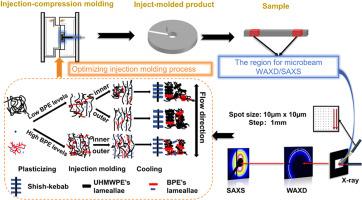The injection molding of large industrial ultrahigh molecular weight polyethylene products: A microbeam WAXD/SAXS investigation of the impaction of bimodal polyethylene on the structure and mechanical properties
IF 4.1
2区 化学
Q2 POLYMER SCIENCE
引用次数: 0
Abstract
The injection molding of ultra-high molecular weight polyethylene (UHMWPE) large industrial products has always been a significant challenge. This study demonstrated that the addition of bimodal polyethylene (BPE) can reduce the melt viscosity of UHMWPE, enabling the injection molding of UHMWPE products with high-performance, large size, and complex shapes. Detailed analyses including microbeam wide-angle X-ray diffraction (WAXD)/small-angle X-ray scattering (SAXS), differential scanning calorimeter (DSC), and scanning electron microscope (SEM) were conducted to investigate the crystal structural differences across various regions of UHMWPE products with different BPE contents. This study revealed that those products with low BPE content exhibited larger lamellar crystal sizes and higher tensile strength, albeit with poor microstructure uniformity, resulting in low elongation at break. Conversely, products with high BPE content had more uniform microstructures but low degrees of crystal perfection, significantly improving elongation at break. Impact performance tests revealed that adding BPE did not damage the mechanical properties of UHMWPE, showing an ultra-high impact strength of 500 kJ/m2. Furthermore, this study identified the significant effect of the complex flow field and molecular weight fraction of BPE on the crystal structure of the products. At low BPE concentrations, the low molecular weight portion of BPE predominated in the plasticizing effect during injection mold. Under weak flow conditions, this increased molecular chain relaxation in UHMWPE, making it difficult to maintain the oriented structure. Conversely, strong flow conditions promoted the formation of the oriented structure. However, at high BPE concentrations, the high molecular weight portion of BPE predominantly hindered the movement of UHMWPE, resulting in chain entanglement that does not improve significantly. In this context, the differences in the injection-molded samples under weak and strong flow conditions are minimal.


大型工业超高分子量聚乙烯制品的注射成型:微束WAXD/SAXS研究双峰聚乙烯对结构和力学性能的影响
超高分子量聚乙烯(UHMWPE)大型工业产品的注射成型一直是一个重大挑战。本研究表明,双峰聚乙烯(BPE)的加入可以降低超高分子量聚乙烯(UHMWPE)的熔体粘度,使超高分子量聚乙烯(UHMWPE)高性能、大尺寸、复杂形状的注塑成型成为可能。采用微束广角x射线衍射(WAXD)/小角x射线散射(SAXS)、差示扫描量热仪(DSC)、扫描电镜(SEM)等详细分析了不同BPE含量的超高分子量聚乙烯(UHMWPE)产品不同区域的晶体结构差异。研究表明,低BPE含量的产品具有较大的片层晶体尺寸和较高的抗拉强度,但其微观组织均匀性较差,导致断裂伸长率较低。相反,BPE含量高的产品显微组织更均匀,但晶体完善度较低,断裂伸长率显著提高。冲击性能试验表明,添加BPE对UHMWPE的力学性能没有影响,其冲击强度达到500 kJ/m2。此外,本研究还发现了BPE的复杂流场和分子量分数对产物晶体结构的显著影响。在低BPE浓度下,BPE的低分子量部分在注塑过程中的塑化效果中占主导地位。在弱流动条件下,这增加了超高分子量聚乙烯的分子链弛豫,使其难以保持取向结构。反之,强流动条件促进了定向结构的形成。然而,在高BPE浓度下,BPE的高分子量部分主要阻碍了UHMWPE的运动,导致链缠结没有明显改善。在这种情况下,在弱和强流动条件下的注射成型样品的差异是最小的。
本文章由计算机程序翻译,如有差异,请以英文原文为准。
求助全文
约1分钟内获得全文
求助全文
来源期刊

Polymer
化学-高分子科学
CiteScore
7.90
自引率
8.70%
发文量
959
审稿时长
32 days
期刊介绍:
Polymer is an interdisciplinary journal dedicated to publishing innovative and significant advances in Polymer Physics, Chemistry and Technology. We welcome submissions on polymer hybrids, nanocomposites, characterisation and self-assembly. Polymer also publishes work on the technological application of polymers in energy and optoelectronics.
The main scope is covered but not limited to the following core areas:
Polymer Materials
Nanocomposites and hybrid nanomaterials
Polymer blends, films, fibres, networks and porous materials
Physical Characterization
Characterisation, modelling and simulation* of molecular and materials properties in bulk, solution, and thin films
Polymer Engineering
Advanced multiscale processing methods
Polymer Synthesis, Modification and Self-assembly
Including designer polymer architectures, mechanisms and kinetics, and supramolecular polymerization
Technological Applications
Polymers for energy generation and storage
Polymer membranes for separation technology
Polymers for opto- and microelectronics.
 求助内容:
求助内容: 应助结果提醒方式:
应助结果提醒方式:


